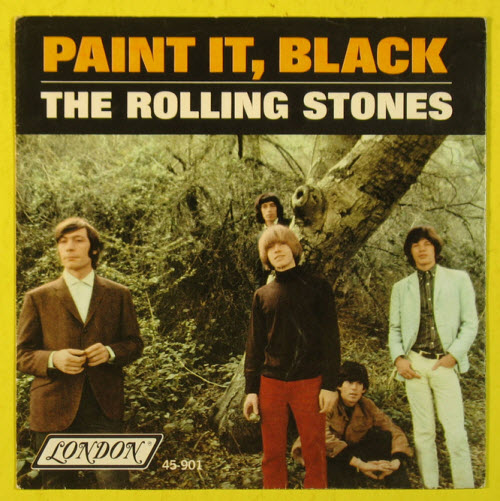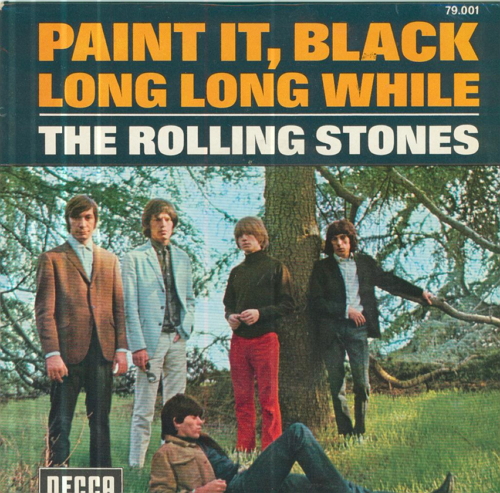Brian Jones plucked the haunting sitar melody at the 1966 L.A. session for this classic. Bill Wyman added klezmer-flavored organ; studio legend Jack Nitzsche played the gypsy-style piano. “Brian had pretty much given up on the guitar by then,” said Richards. “If there was [another] instrument around, he had to be able to get something out of it. It gave the Stones on record a lot of different textures.”
~rollingstone.comThe principal riff of “Paint It Black” (almost all classic Rolling Stones songs are highlighted by a killer riff) was played on a sitar by Brian Jones and qualifies as perhaps the most effective use of the Indian instrument in a rock song. The exotic twang was a perfect match for the dark, mysterious Eastern-Indian melody, which sounded a little like a soundtrack to an Indian movie hijacked into hyperdrive.
~Richie Unterberger (allmusic.com)
Original version:
Wikipedia:
| from the album Aftermath | |
|---|---|
| B-side | “Stupid Girl” (US) “Long Long While” (UK) |
| Released | 7 May 1966 (US) 13 May 1966 (UK) |
| Format | 7″ |
| Recorded | 6–9 March 1966 |
| Genre | Psychedelic rock, raga rock |
| Length | 3:45 (mono single mix) 3:22 (stereo album mix) |
| Label | London 45-LON.901 (US) Decca F.12395 (UK) |
| Writer(s) | Jagger/Richards |
| Producer | Andrew Loog Oldham |
“Paint It, Black” is a song released by The Rolling Stones on 13 May 1966 (7 May 1966 – US) as the first single from the US version of their fourth album Aftermath. It was originally titled “Paint It Black” without a comma. Keith Richards has stated that the comma was added by the record label, Decca.
- At a book signing in Nashville in 2001, Bill Wyman explained that the comma was simply a typographical error that stuck.
- The song was written by Mick Jagger and Keith Richards. Mick Jagger wrote the lyrics and Keith Richards wrote the music.
- Bill Wyman claims in his books that the song was a group effort although it was credited to Jagger/Richards.
- The single reached number one in both the United States and the United Kingdom charts in 1966.
- In 2004 it was ranked number 176 on Rolling Stone magazine’s list of the 500 Greatest Songs of All Time. In the US and UK, it was the first number one single to feature a sitar.
Live version:
Musicians:
- Mick Jagger – lead vocals
- Brian Jones – sitar, percussion
- Keith Richards – electric guitar, acoustic guitar, backing vocals
- Bill Wyman – bass pedals, bass guitar, Hammond B3
- Charlie Watts – drums
- Jack Nitzsche – piano
Today’s Playlist:
Other May-07
- Alice is an album by Tom Waits, released in 2002 on Epitaph Records (under the Anti sub-label). The album contains the majority of songs written for the play Alice. The adaptation was directed by Robert Wilson, whom Waits had previously worked with on the play The Black Rider, and originally set up at the Thalia Theatre inHamburg in 1992. The play has since been performed in various theatres around the world.
-
Released May 7, 2002 Genre Rock Length 48:23 Label ANTI- Producer Kathleen Brennan
Tom Waits - Jimmy Lee Ruffin (born May 7, 1939) is an American soul singer, and elder brother of David Ruffin of The Temptations. He had several hit records between the 1960s and 1980s, the most successful being “What Becomes of the Brokenhearted.”
 –
– - Edward Thomas “Eddie” Rabbitt (November 27, 1941 – May 7, 1998) was an American singer-songwriter and musician. His career began as a songwriter in the late 1960s, springboarding to a recording career after composing hits such as “Kentucky Rain” for Elvis Presley in 1970 and “Pure Love” for Ronnie Milsap in 1974. Later in the 1970s, Rabbitt helped to develop the crossover-influenced sound of country music prevalent in the 1980s with such hits as “Suspicions” and “Every Which Way but Loose.” His duets “Both to Each Other (Friends and Lovers)” and “You and I”, with Juice Newton and Crystal Gayle respectively, later appeared on the soap operasDays of Our Lives and All My Children.
-Egil




